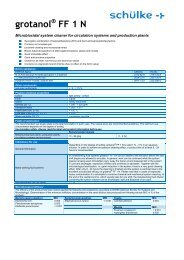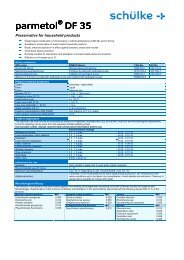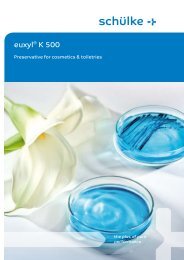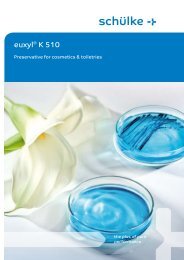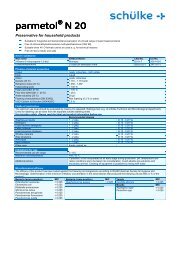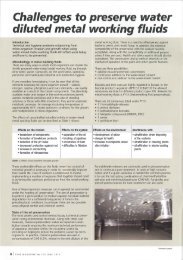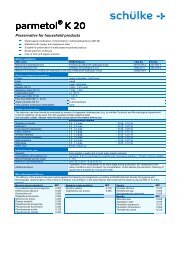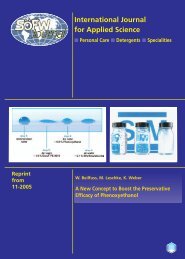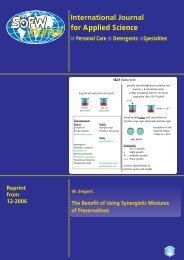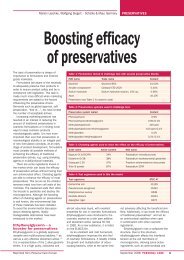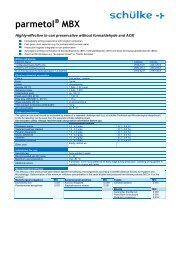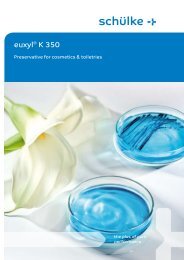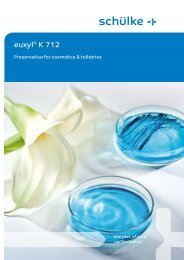ISO 11930 â A Comparison to other Methods to ... - ResearchGate
ISO 11930 â A Comparison to other Methods to ... - ResearchGate
ISO 11930 â A Comparison to other Methods to ... - ResearchGate
You also want an ePaper? Increase the reach of your titles
YUMPU automatically turns print PDFs into web optimized ePapers that Google loves.
7-2012<br />
English Edition<br />
International Journal for Applied Science<br />
• Personal Care • Detergents • Specialties<br />
W. Siegert:<br />
<strong>ISO</strong> <strong>11930</strong> –<br />
A <strong>Comparison</strong> <strong>to</strong><br />
<strong>other</strong> <strong>Methods</strong> <strong>to</strong> Evaluate the<br />
Efficacy of Antimicrobial<br />
Preservation
COSMETICS<br />
PRESERVATION<br />
W. Siegert*<br />
<strong>ISO</strong> <strong>11930</strong> – A <strong>Comparison</strong> <strong>to</strong> <strong>other</strong> <strong>Methods</strong><br />
<strong>to</strong> Evaluate the Efficacy of Antimicrobial<br />
Preservation<br />
■ Legal Regulations<br />
Only in the SCCS notes of guidance, the<br />
demands for challenge testing are specified.<br />
In paragraph 4-4 »Guidelines on Microbiological<br />
of the Finished Cosmetic<br />
Product« in the 7 th revision (December<br />
2010) (7) of the SCCS publication »Notes<br />
of Guidance for the Testing of Cosmetic<br />
Ingredients and their Safety Evaluation«<br />
is an obligation for carrying out a preservation<br />
test with all cosmetic products<br />
which could be contaminated under<br />
normal s<strong>to</strong>rage and usage conditions or<br />
if an infection risk for the consumer exists.<br />
The use of Pseudomonas aeruginosa,<br />
Staphylococcus aureus and Candida albicans<br />
from official collection strains<br />
from any state within the EU is obliga<strong>to</strong>ry.<br />
In addition, the use of specific germs,<br />
which are known <strong>to</strong> lead <strong>to</strong> spoilage of<br />
cosmetic products, is recommended.<br />
■ <strong>ISO</strong> <strong>11930</strong><br />
Compared <strong>to</strong> <strong>other</strong> methods <strong>ISO</strong> <strong>11930</strong> is<br />
an overall standard <strong>to</strong> evaluate the antimicrobial<br />
stabilisation of a cosmetic product.<br />
With the decision diagram in Annex<br />
A also formulations intrinsically hostile<br />
<strong>to</strong> microbial growth, specific manufacturing<br />
conditions, packaging and/or conditions<br />
for use and the reference <strong>to</strong> <strong>ISO</strong><br />
29261 (Guidelines for the risk assessment<br />
and identification of microbiologically<br />
low-risk products) (7) are covered.<br />
Nevertheless, the preservative efficacy<br />
test described in <strong>ISO</strong> <strong>11930</strong> is primarily<br />
designed for water-soluble or water-miscible<br />
products.<br />
This publication compares the following<br />
test methods:<br />
• <strong>ISO</strong> <strong>11930</strong> »Evaluation of the antimicrobial<br />
protection of a cosmetic product«<br />
(1)<br />
• SCCS »Notes of Guidance for the Testing<br />
of Cosmetic Ingredients and their<br />
Safety Evaluation« (7)<br />
• schülke KoKo test »Determination of<br />
the Preserving Effect of Chemical<br />
Preservatives in Cosmetic Formulations«<br />
Introduction<br />
• Ph. Eur. 7 - 5.1.3 »Efficacy of Antimicrobial<br />
Preservation«(3)<br />
• USP 35 »Antimicrobial Effectiveness<br />
Testing« (4)<br />
• ASEAN ACM MAL 08 »Preservative Efficacy<br />
Test for Cosmetic Product« (5)<br />
• CTFA M-3 »A Method for Preservation<br />
Testing of Water-Miscible Personal<br />
Care Products« (6)<br />
• CTFA M-4 »Method for Preservation<br />
Testing of Eye Area Cosmetics« (6).<br />
The first edition of <strong>ISO</strong> <strong>11930</strong> (1) was published in April 2012 under the<br />
title »Cosmetics – Microbiology – Evaluation of the antimicrobial protection<br />
of a cosmetic product«. This test can be used <strong>to</strong> evaluate the<br />
preservation of a cosmetic formulation.<br />
While the regulation on cosmetic products (EC 1223/2009) (2) requires<br />
that the cosmetic product safety report demonstrates the results of preservation<br />
challenge test <strong>to</strong> prove the microbiological stability, it does not<br />
specify the test procedure for the challenge test. In addition <strong>to</strong> <strong>ISO</strong> <strong>11930</strong><br />
tests from the EU (3) and US pharmacopoeia (4), the ASEAN preservative<br />
efficacy test (5), the test from the CTFA Microbiology Guidelines (6) as well<br />
as several in-house test pro<strong>to</strong>cols have been established for many years.<br />
This paper includes a comparison of the different methods and comparative<br />
test results for <strong>ISO</strong> <strong>11930</strong>, Ph. Eur. 7 and the schülke KoKo Test.<br />
44 SOFW-Journal | 138 | 7-2012
COSMETICS<br />
PRESERVATION<br />
Table 1 Microorganisms used for <strong>ISO</strong> <strong>11930</strong>, SCCS recommendation Ph. Eur. 7, USP 35, ASEAN<br />
Other test methods not included in this<br />
study might be of interest for special applications:<br />
• CTFA M-5 <strong>Methods</strong> for Preservation<br />
Testing of Nonwoven Substrate Personal<br />
Care Products (6)<br />
• CTFA M-6 A Method for Preservation<br />
Testing of Atypical Personal Care<br />
Products (6)<br />
• CTFA M-7 A Rapid Method for Preservation<br />
Testing of Water-Miscible Personal<br />
Care Products (6)<br />
• schülke FeuTuKo test »Method <strong>to</strong><br />
Determine the Preserving Effect of<br />
Chemical Preservatives in Wet Tissues«.<br />
more species. Nevertheless, the CTFA<br />
methods have the biggest variability, only<br />
the use of different types of microorganisms<br />
is specified (Table 2 and 3).<br />
The <strong>ISO</strong> <strong>11930</strong>, the Ph. Eur 7, the USP 35<br />
and the ASEAN tests use only pathogenic<br />
microorganisms, they only partly fulfil the<br />
recommendation of the SCCS <strong>to</strong> use additional<br />
specific germs which are known<br />
<strong>to</strong> lead <strong>to</strong> spoilage of cosmetic products.<br />
The CTFA includes in their selection lists<br />
typical product spoiling microorganisms,<br />
Test microorganisms<br />
The microorganisms used for the different<br />
tests are listed in Table 1 <strong>to</strong> 3. The test<br />
methods from the CTFA Microbiology<br />
Guidelines differentiate between testing<br />
of eye area cosmetics and <strong>other</strong> water<br />
miscible cosmetic products. Eye cosmetics<br />
are recommended <strong>to</strong> be tested with<br />
Table 2 Microorganisms recommended for CTFA / M-3 A Method for Preservation<br />
Testing of Water-Miscible Personal Care Products<br />
SOFW-Journal | 138 | 7-2012 45
COSMETICS<br />
PRESERVATION<br />
they can be tested instead ore in addition<br />
<strong>to</strong> pathogenic species.<br />
The schülke KoKo test includes these microorganisms,<br />
selected using decades of<br />
experience from schülke’s support services<br />
<strong>to</strong> cosmetic producers through the<br />
scope of MQM (Microbiological Quality-<br />
Management). Only the schülke KoKo<br />
test completely fulfil recommendations<br />
of the SCCS Notes of Guidance.<br />
■ Cultivation of<br />
Test Microorganisms<br />
The cultivation of the test germs is comparable<br />
for all methods including the<br />
schülke KoKo test. Fig. 1 shows the procedure<br />
of single-strain cultivation on<br />
agar plates.<br />
Table 3 Microorganisms used for CTFA / M-4 Method for Preservation Testing of<br />
Eye Area Cosmetics<br />
■ Production of Inoculum<br />
For the production of an inoculum, microorganisms<br />
are washed off from the<br />
nutrient media. For the production of an<br />
inoculum, microorganisms are washed<br />
off from the nutrient media plates and<br />
adjusted <strong>to</strong> the required starting germ<br />
count by dilution. The inoculum is then<br />
directly used <strong>to</strong> inoculate the test samples<br />
according <strong>to</strong> <strong>ISO</strong> <strong>11930</strong>, Ph. Eur. 7<br />
and ASEAN. The CTFA tests accepts the<br />
use of either as well pure or mixed culture<br />
suspensions, the schülke KoKo test<br />
uses mixed culture suspensions (i.e. single<br />
cultivated microorganisms brought<br />
<strong>to</strong>gether in<strong>to</strong> a mixed suspension). To<br />
guarantee a constant composition of the<br />
mixed inoculum the mixed suspension is<br />
s<strong>to</strong>red for maximum of three days in a<br />
refrigera<strong>to</strong>r. A new inoculation suspension<br />
is prepared for each inoculation cycle.<br />
■ Inoculation of Samples<br />
The microorganism counts used and the<br />
quantity of the inoculum are demonstrated<br />
in Table 4.<br />
All tests have similar germ loads in the<br />
inoculated sample. The <strong>to</strong>tal germ count<br />
of the inoculum for the schülke KoKo<br />
test was slightly higher <strong>to</strong> ensure safe<br />
preservation <strong>to</strong> compensate for less clean<br />
Fig. 1 Cultivation of test germs for the schülke KoKo Test<br />
production facilities. As there is now the<br />
legal demand <strong>to</strong> produce cosmetic products<br />
according <strong>to</strong> <strong>ISO</strong> 22716 (Guidelines<br />
on Good Manufacturing Practices) (9),<br />
the germ count has recently been adapted<br />
bringing it in<strong>to</strong> line with the <strong>other</strong> test<br />
models.<br />
■ Criteria of Acceptance<br />
<strong>ISO</strong> <strong>11930</strong> (Table 5)<br />
If the formulation meets criteria A, the<br />
microbiological risk is considered <strong>to</strong> be<br />
<strong>to</strong>lerable (the cosmetic product is protected<br />
against microbial proliferation<br />
that may present a potential risk for the<br />
user) and the cosmetic product is deemed<br />
<strong>to</strong> meet the requirements of this International<br />
Standard without additional rationale<br />
(1).<br />
If the formulation meets criteria B, the<br />
microbiological risk analysis shall demonstrate<br />
the existence of control fac<strong>to</strong>rs<br />
not related <strong>to</strong> the formulation; for example,<br />
a protective package such as a<br />
pump provides a higher level of protection<br />
than a jar (see Annex D, <strong>ISO</strong> <strong>11930</strong>).<br />
46 SOFW-Journal | 138 | 7-2012
COSMETICS<br />
PRESERVATION<br />
Table 4 Microorganism counts and the quantity of inoculum used for challenge testing<br />
This would be considered a protective<br />
device for risk reduction (1).<br />
If the formulation meets criteria B, the<br />
microbiological risk analysis shall demonstrate<br />
the existence of control fac<strong>to</strong>rs not<br />
related <strong>to</strong> the formulation; for example,<br />
a protective package such as a pump provides<br />
a higher level of protection than a<br />
schülke KoKo test (Table 6)<br />
If a sample passes criteria A, this means<br />
that even after the sixth inoculation no<br />
microbial growth can be observed, the<br />
product can be considered <strong>to</strong> be well<br />
preserved. From many years of experience<br />
in the use of this test method, if a<br />
product passes criteria A we can state the<br />
microbiological stability of 30 months,<br />
which is recommended for cosmetic<br />
products.<br />
Table 5 <strong>ISO</strong> <strong>11930</strong> / Criteria of acceptance<br />
48 SOFW-Journal | 138 | 7-2012
COSMETICS<br />
PRESERVATION<br />
jar and/or following strong demands on<br />
good manufacturing practice.<br />
Ph. Eur. 7 (Table 7)<br />
The A criteria express the recommended<br />
efficacy <strong>to</strong> be achieved. In justified cases<br />
where the A criteria cannot be attained,<br />
for example, for reasons of an increased<br />
risk of adverse reactions, the B<br />
criteria must be satisfied.<br />
Table 6 schülke KoKo test / Criteria of acceptance<br />
USP 35 (Table 8)<br />
ASEAN (Table 9)<br />
CTFA / M-3 (Table 10)<br />
CTFA / M-4 (Table 11)<br />
Table 7 Ph. Eur 7 / Criteria of acceptance<br />
■ Preservative Stability<br />
Preservative stability is an important<br />
fac<strong>to</strong>r <strong>to</strong> ensure the microbial quality.<br />
The SCCS requires (7):<br />
• The efficacy of the preservation of a<br />
cosmetic product under development<br />
has <strong>to</strong> be assessed experimentally in<br />
order <strong>to</strong> ensure microbial stability and<br />
preservation during s<strong>to</strong>rage and use.<br />
To ensure a safe preservation over the<br />
shelf life of a cosmetic product a single<br />
inoculation of a fresh prepared sample is<br />
insufficient. Degradation or inactivation<br />
of actives may occur, e.g. methylchloroisothiazolinone<br />
or bronopol at alkaline<br />
pH.<br />
<strong>ISO</strong> <strong>11930</strong><br />
There is no hint <strong>to</strong> preservative stability<br />
in <strong>ISO</strong> <strong>11930</strong>.<br />
schülke KoKo test<br />
The six fold inoculation includes au<strong>to</strong>matically<br />
a preservative stability check,<br />
the sixth inoculation is performed on at<br />
least six weeks old sample. Practical experience<br />
has shown that this time scale<br />
is sufficient <strong>to</strong> ensure microbial quality.<br />
Ph. Eur. 7<br />
The Ph. Eur. stipulates <strong>to</strong> investigate the<br />
antimicrobial activity with s<strong>to</strong>red samples:<br />
Table 8 USP 35 / Criteria of acceptance<br />
Table 9 ASEAN / Criteria of acceptance<br />
Table 10 CTFA / M-3 / Criteria of acceptance<br />
Table 11 CTFA / M-4 Eye area cosmetics / Criteria of acceptance<br />
SOFW-Journal | 138 | 7-2012 49
COSMETICS<br />
PRESERVATION<br />
• The antimicrobial activity of the preparation<br />
in its final container is investigated<br />
over the period of validity <strong>to</strong><br />
ensure that such activity has not been<br />
impaired by s<strong>to</strong>rage.<br />
USP 35<br />
The USP 35 does not address the issue of<br />
stability; there is only the statement:<br />
• The tests and criteria for effectiveness<br />
apply <strong>to</strong> a product in the original, unopened<br />
container in which it was distributed<br />
by the manufacturer.<br />
ASEAN<br />
There is no hint <strong>to</strong> preservative stability<br />
in the ASEAN test.<br />
CTFA / M-3<br />
Under »Other Considerations« the s<strong>to</strong>rage<br />
stability is included:<br />
Unpreserved lotion -<br />
Preservative System<br />
Lotion preservative 1 1.0 % combination phenoxyethanol / ethylhexylglycerin 1)<br />
Lotion preservative 2 1.1 % combination phenoxyethanol / ethylhexylglycerin 1)<br />
Lotion preservative 3 1.0 % combination phenoxyethanol / ethylhexylglycerin 1)<br />
0.1 % ethylhexylglycerin (preservative booster) 2)<br />
Lotion preservative 4 1.0 % combination phenoxyethanol / ethylhexylglycerin 1)<br />
0.06 % combination ethylhexylglycerin / methylisothiazolinone<br />
3)<br />
Lotion preservative 5 1.0 % combination phenoxyethanol / benzyl alcohol /<br />
potassium sorbate 4) (pH adjusted <strong>to</strong> 5.3)<br />
Lotion preservative 6 1 % combination phenoxyethanol / benzoic acid /<br />
dehydroacetic acid / ethylhexylglycerin / polyaminopropyl<br />
biguanide 5) (pH adjusted <strong>to</strong> 5.1)<br />
1)<br />
euxyl® PE 9010<br />
2)<br />
sensiva® SC 50<br />
3)<br />
euxyl® K 220<br />
4)<br />
euxyl® K 700<br />
5)<br />
euxyl® K 702<br />
Table 12 Selected preservative systems used in the challenge test<br />
• It is important that challenge tests also<br />
be conducted on samples aged in<br />
the final container in order <strong>to</strong> determine<br />
the stability of the preservative<br />
system.<br />
CTFA / M-4<br />
For eye area cosmetic it is clearly stated<br />
in the guidelines:<br />
• Product should be evaluated for<br />
preservative stability in commercial<br />
packaging by testing after s<strong>to</strong>rage<br />
that simulates warehouse, shipping<br />
and shelf-life conditions.<br />
■ Experimental Data<br />
Using a body lotion containing Q10 from<br />
an actual market request, we ran the<br />
preservative efficacy tests according <strong>to</strong><br />
<strong>ISO</strong> <strong>11930</strong> in comparison <strong>to</strong> Ph. Eur. 7 and<br />
the schülke KoKo test. Formulations containing<br />
coenzyme Q-10 (ubichinone) are<br />
known <strong>to</strong> be more susceptible <strong>to</strong> mould<br />
growth. Table 12 shows the preservative<br />
systems that have been selected for the<br />
challenge test.<br />
For the <strong>ISO</strong> <strong>11930</strong> and Ph. Eur. test reduction<br />
in microbial counts are expressed<br />
in log units (R x<br />
=lgN 0<br />
– lgN x<br />
). Negative<br />
figures indicate an increase of the microbial<br />
count in the test sample.<br />
For the KoKo test, the preserving effect<br />
is evaluated semi-quantitatively by the<br />
growth of different streaks. The microbial<br />
growth is classified in bacteria, yeasts<br />
and moulds according <strong>to</strong> the following<br />
legend:<br />
B = Bacteria<br />
M = Moulds<br />
Sp = Sporeforming bacteria<br />
Y = Yeasts<br />
- = free of growth<br />
+ = slight growth<br />
++ = moderate growth<br />
+++= heavy growth<br />
Table 13 Test results unpreserved lotion<br />
Table 14 <strong>to</strong> 19 display the results achieved<br />
with the different preservative systems.<br />
■ Summary Experimental Data<br />
Table 20 summarises the assessment of<br />
the antimicrobial protection with regards<br />
<strong>to</strong> the different test methods.<br />
The criteria of acceptance for <strong>ISO</strong> <strong>11930</strong><br />
appear <strong>to</strong> be the easiest <strong>to</strong> fulfil. It is<br />
questionable if the demands of protection<br />
for a cosmetic product should not<br />
be stricter than for pharmaceutical<br />
products. The test for efficacy of antimicrobial<br />
preservation according <strong>to</strong> EU<br />
Pharmacopoeia and the criteria of acceptance<br />
are designed for the produc-<br />
50 SOFW-Journal | 138 | 7-2012
COSMETICS<br />
PRESERVATION<br />
tion of drugs under the strong requirements<br />
of the pharmaceutical GMP (Good<br />
Manufacturing Practice). Additionally the<br />
Table 14 Test results lotion preservative 1<br />
useable lifespan after opening of cosmetic<br />
products are generally longer than<br />
for pharmaceutical products.<br />
The schülke KoKo test is specifically verified<br />
for the assessment of cosmetic<br />
products. From more than 25 years of experience<br />
(11, 12) with this test method,<br />
we can state a 30 month microbiological<br />
stability for a product passing criteria<br />
A, which is recommended for cosmetic<br />
products.<br />
The lotion with the preservative system<br />
1 passed only <strong>ISO</strong> <strong>11930</strong> and Ph. Eur. criteria<br />
B. Nevertheless, even 28 days after<br />
the inoculation with Aspergillus brasiliensis<br />
it was still detectable. Within 7 days<br />
the decrease of moulds is insufficient,<br />
the KoKo failed.<br />
The lotion with the preservative system<br />
2 and 3 passed <strong>ISO</strong> <strong>11930</strong> and Ph. Eur.;<br />
KoKo showed only slight growth in the<br />
last cycles, it fulfils criteria B.<br />
Table 15 Test results lotion preservative 2<br />
Table 16 Test results lotion preservative 3<br />
Precision and reproducibility of<br />
preservative efficacy tests<br />
To assess the differences of the results in<br />
the various test methods, it is important<br />
<strong>to</strong> realise the variation in microbiological<br />
test results. The GÖCH has published<br />
the results of a round robin test for Ph.<br />
Eur. - 5.1.3 »Efficacy of Antimicrobial<br />
Preservation« (10). The microbial counts<br />
differed widely between the labora<strong>to</strong>ries.<br />
Fig. 2 shows an overview of the results<br />
including expanded uncertainty.<br />
For the <strong>other</strong> methods this data is not<br />
available, probably however it can be assumed<br />
that it will be in the same range.<br />
Borderline results with low reduction in<br />
microbial counts might fail in a replicate.<br />
Uncertain contaminations during production<br />
combined with an insufficient<br />
speed of killing may lead <strong>to</strong> detection of<br />
contamination in the market place. The<br />
worst case is the inclusion in the RAPEX<br />
notifications (13).<br />
■ Conclusion<br />
Table 17 Test results lotion preservative 4<br />
The <strong>ISO</strong> <strong>11930</strong> as new standard <strong>to</strong> evaluate<br />
the antimicrobial protection of a<br />
cosmetic product includes reference<br />
method <strong>to</strong> evaluate the preservation, as<br />
well as a decision diagram <strong>to</strong> evaluate<br />
the microbiological risk. The recommended<br />
preservation efficacy test is less strict<br />
than the Ph. Eur. and the KoKo test (see<br />
Experimental data). The microbial strains<br />
SOFW-Journal | 138 | 7-2012 51
COSMETICS<br />
PRESERVATION<br />
Table 18 Test results lotion preservative 5<br />
did not include typical product spoiling<br />
microorganisms alongside the pathogenic<br />
germs as required by the SCCS (7). The<br />
stability of a preservative is not taken in<strong>to</strong><br />
account by <strong>ISO</strong> <strong>11930</strong>.<br />
Formulations passing KoKo or Ph. Eur.<br />
criteria A can be also evaluated as safe<br />
according <strong>to</strong> <strong>ISO</strong> <strong>11930</strong> criteria A.<br />
It is likely that products tested according<br />
<strong>to</strong> CTFA M-3 or M-4 will be safe as the<br />
requirement for a germ count reduction<br />
within seven days is more rigorous than<br />
that of <strong>ISO</strong> <strong>11930</strong> and comparable <strong>to</strong> the<br />
KoKo test.<br />
The ASEAN test is comparable <strong>to</strong> <strong>ISO</strong><br />
<strong>11930</strong>.<br />
The USP 35 can be considered as a weak<br />
standard; the demands are below those<br />
for <strong>ISO</strong> <strong>11930</strong>. It is advisable <strong>to</strong> perform<br />
a test according <strong>to</strong> one of the methods<br />
designed for cosmetics.<br />
References<br />
Table 19 Test results lotion preservative 6<br />
Table 20 Summary experimental data<br />
(1) <strong>ISO</strong> <strong>11930</strong>, Cosmetics - Microbiology - Evaluation<br />
of the antimicrobial protection of a<br />
cosmetic product<br />
(2) Regulation (EC) No 1223/2009 of the European<br />
parliament and the council of Europe of<br />
30 November 2009 on cosmetic products<br />
http://eur-lex.europa.eu/LexUriServ/LexUri<br />
Serv.do?uri=OJ:L:2009:342:0059:0209:EN:<br />
PDF<br />
(3) European Pharmacopeia 7 th edition, 5.1.3. Efficacy<br />
of antimicrobial preservation<br />
(4) United States Pharmacopoeia (USP 35); 51<br />
Antimicrobial effectiveness testing<br />
(5) Association of Southeast Asian Nations, Preservative<br />
efficacy test for cosmetic product,<br />
Document N° ACM MAL 08<br />
(6) Personal Care Products Council (PCPC - formerly<br />
the Cosmetic, Toiletry and Fragrance<br />
Association); CTFA Microbiology Guidelines<br />
2007<br />
(7) Scientific Committee on Consumer Safety<br />
(SCCS), The SCCS's Notes of Guidance for the<br />
Testing of Cosmetic Ingredients and their<br />
Safety Evaluation, 7 th Revision<br />
Fig. 2 GÖCH results of round robin test including expanded uncertainty<br />
(8) <strong>ISO</strong> 29621, Cosmetics - Microbiology - Guidelines<br />
for the risk assessment and identification<br />
of microbiologically low-risk products<br />
52 SOFW-Journal | 138 | 7-2012
COSMETICS<br />
PRESERVATION<br />
(9) <strong>ISO</strong> 22716; Cosmetics - Good Manufacturing<br />
Practices (GMP) – Guidelines on Good Manufacturing<br />
Practices<br />
(10) GÖCH Arbeitskreis »Mikrobiologie«, Zwischenbericht<br />
Ringversuch Konservierungsbelastungstest<br />
(KBT) kosmetische Mittel http://<br />
www.goech.at/files/2011_GOECH_Arbeits<br />
kreis_1_Veroeffentlichung_110118.pdf<br />
(11) Siegert W., Evaluation of the Microbiological<br />
Safety of Finished Cosmetic Products, Euro<br />
Cosmetics 3-2010<br />
(12) Brill H., Prüfverfahren zur Bestimmung der<br />
mikrobiologischen Wirksamkeit con chemischen<br />
Konservierungsmitteln für Kosmetika,<br />
Jahrbuch für den Praktiker 1987<br />
(13) European Commission, RAPEX – Latest notifications,<br />
http://ec.europa.eu/consumers/dyna/<br />
rapex/rapex_archives_en.cfm<br />
* Author’s address:<br />
Wolfgang Siegert<br />
Schülke & Mayr GmbH<br />
Robert-Koch-Straße 2<br />
22851 Norderstedt<br />
Germany<br />
Email: wolfgang.siegert@schuelke.com<br />
■<br />
SOFW-Journal | 138 | 7-2012 53




